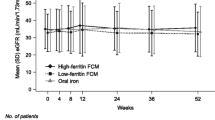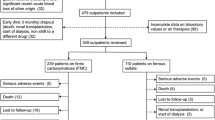Abstract
Background
Iron deficiency anemia occurs in most patients with non-dialysis chronic kidney disease (ND-CKD). Previous studies have suggested that intravenous (IV) iron therapy is more effective than oral iron in these patients. Clinical evidence relating the effects of IV iron on renal function is, however, limited.
Methods
Prospective observational study of adult patients with ND-CKD, anemia, iron deficiency, and estimated glomerular filtration rate (eGFR) < 60 mL/min/1.73 m2, treated with a single dose of 500 mg or 1000 mg of ferric carboxymaltose (FCM) and followed-up for 24 weeks. Primary outcome was FCM efficacy, assessed by comparing Hb, TSAT and ferritin at 24 weeks with those at baseline. Secondary outcome was FCM impact on renal function, evaluated by comparing eGFR over the same period.
Results
One hundred and forty patients were recruited: seventy-eight (55.7%) were treated with 1000 mg and 62 (44.3%) with 500 mg of FCM. 24 weeks after FCM administration, Hb increased 1.54 ± 1.99 g/dL (95% CI 1.09–1.99, p = 001) in the group treated with 1000 mg and 0.86 ± 1.4 g/dL (95% CI 0.53–1.22, p = 0.001) in those treated with 500 mg. TSAT increased in both groups but more in those treated with 1000 mg, and ferritin only increased in the latter. Estimated GFR showed a significant increase of 1.55 ± 6.86 mL/min/m2 (95% CI 0.05–3.09, p = 0.049), from a baseline of 27.73 ± 17.23 to 28.88 ± 18.02 mL/min/m2 in the group treated with 1000 mg.
Conclusions
Our findings suggested that IV FCM therapy was effective in improving serum iron levels and anemia in ND-CKD stage 3 to 5 patients. Higher doses seem to be necessary to replace depleted iron stores. In our cohort, IV FCM therapy was associated with an improvement in renal function, particularly in those treated with higher doses of FCM.

Similar content being viewed by others
References
Minutolo R, Locatelli F, Gallieni M et al (2013) Anaemia management in non-dialysis chronic kidney dis-ease (CKD) patients: a multicenter prospective study in renal clinics. Nephrol Dial Transpl 28:3035–3045
Stack AG, Alghali A, Li X et al (2017) Quality of care and practice patterns in anaemia management at specialist kidney clinics in Ireland: a national study. Clin Kidney J 11:99–107
Babitt JL, Eisenga MF, Haase VH et al (2021) Controversies in optimal anemia management: conclusion from a Kidney Disease: improving Global Outcomes (KDIGO) Conference. Kidney Int 6:1280–1295
Kidney Disease: Improving Global Outcomes (KDIGO) Anemia Work Group (2012) KDIGO clinical practice guideline for anemia in chronic kidney disease. Kidney Int Suppl 2:279–335
Locatelli F, Bárány P, Covic A et al (2013) Kidney disease: improving global outcomes guidelines on anaemia management in chronic kidney disease: a European Renal Best Practice position statement. Nephrol Dial Transpl 28:1346–1359
Qunibi WY, Martinez C, Smith M et al (2011) A randomized controlled trial comparing intravenous ferric carboxymaltose with oral iron for treatment of iron deficiency anaemia of non-dialysis-dependent chronic kidney disease patients. Nephrol Dial Transpl 26:1599–1607
Charytan C, Bernardo MV, Koch TA et al (2013) Intravenous ferric carboxy maltose versus standard medical care in the treatment of iron deficiency anemia in patients with chronic kidney disease: a randomized, active-controlled, multi-center study. Nephrol Dial Transpl 28:953–964
Macdougall IC, Bock AH, Carrera F, FIND-CKD Study Investigators et al (2014) FIND-CKD: a randomized trial of intravenous ferric carboxymaltose versus oral iron in patients with chronic kidney disease and iron deficiency anaemia. Nephrol Dial Transplant 29:2075–2084
Agarwal R, Kusek JW, Pappas MK (2015) A randomized trial of intravenous and oral iron in chronic kidney disease. Kidney Int 88:905–914
Dunn LL, Rahmanto YS, Richardson DR (2007) Iron uptake and metabolism in the new millennium. Trends Cell Biol 17:93–100
Beard JL (2001) Iron biology in immune function, muscle metabolism and neuronal functioning. J Nutr 131(Suppl 2):568S-579S
Anker SD, Colet JC, Filippatos G, FAIR-HF Trial Investigators et al (2009) Ferric carboxymaltose in patients with heart failure and iron deficiency. N Engl J Med 361:2436–2448
Ponikowski P, Filippatos G, Colet JC, FAIR-HF Trial Investigators et al (2015) The impact of intravenous ferric carboxymaltose on renal function: an analysis of the FAIR-HF study. Eur J Heart Fail 17:329–339
Minutolo R, Garofalo C, Chiodini P et al (2021) Types of erythropoiesis-stimulating agents and risk of end-stage kidney disease and death in patients with non-dialysis chronic kidney disease. Nephrol Dial Transpl 36(2):267–274
Seliger SL, Zhang AD, Weir MR et al (2011) Erythropoiesis-stimulating agents increase the risk of acute stroke in patients with chronic kidney disease. Kidney Int 80(3):288–294
Agarwal R, Vasavada N, Sachs NG et al (2004) Oxidative stress and renal injury with intravenous iron in patients with chronic kidney disease. Kidney Int 65:2279–2289
Minutolo R, Berto P, Liberti ME et al (2021) Ferric carboxymaltose in non-hemodialysis CKD patients: a longitudinal cohort study. J Clin Med 10(6):1322
Funk F, Ryle P, Canclini C et al (2010) The new generation of intravenous iron: chemistry, pharmacology, and toxicology of ferric carboxymaltose. Arzneimittelforschung 60:345–353
Funding
No funds, grants, or other support was received.
Author information
Authors and Affiliations
Contributions
M.R. collected data and wrote the manuscript. R.E., H.G., and A.V.L critically revised the manuscript.
Corresponding author
Ethics declarations
Conflict of interest
The authors have no conflicts of interest to declare that are relevant to the content of this article.
Additional information
Publisher's Note
Springer Nature remains neutral with regard to jurisdictional claims in published maps and institutional affiliations.
Rights and permissions
Springer Nature or its licensor holds exclusive rights to this article under a publishing agreement with the author(s) or other rightsholder(s); author self-archiving of the accepted manuscript version of this article is solely governed by the terms of such publishing agreement and applicable law.
About this article
Cite this article
Roldão, M., Escoli, R., Gonçalves, H. et al. Efficiency of ferric carboxymaltose in non-dialysis CKD patients and its impact on kidney function: a prospective observational study. Int Urol Nephrol 55, 953–959 (2023). https://doi.org/10.1007/s11255-022-03360-9
Received:
Accepted:
Published:
Issue Date:
DOI: https://doi.org/10.1007/s11255-022-03360-9




